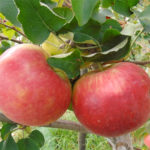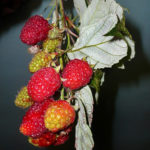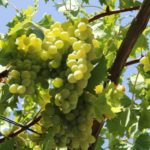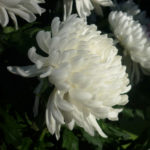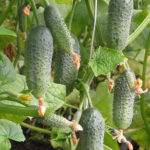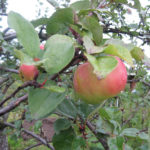Apple variety Gala
Gala is a late autumn (sometimes referred to as early winter) diploid apple variety, bred in 1962 (according to another version - in 1957) in New Zealand by breeder J.H. Kidd as a result of crossing two varieties - Golden Delicious (Golden Delicious) x Kidd's Orange Red. The new variety quickly gained worldwide popularity (2nd place in the world for apple production), almost immediately after its breeding, its orchards were planted in the USA, Canada, Brazil, and Europe. In the North American continent and in the UK, the Gala apple tree has become a leader in the industrial cultivation of apples, along with such world famous varieties as Red Delicious and Golden Delicious. Many English farmers and gardeners began to cultivate this apple tree back in the 80s on a commercial basis. Gala currently accounts for about 20% of the total British commercial apple production. In the mid-70s, this apple tree began to undergo an initial test in experimental plantations of Ukraine, and in 1993 it was zoned in the steppe zone. But still, Gala occupies an insignificant place in the plantings of industrial gardens.
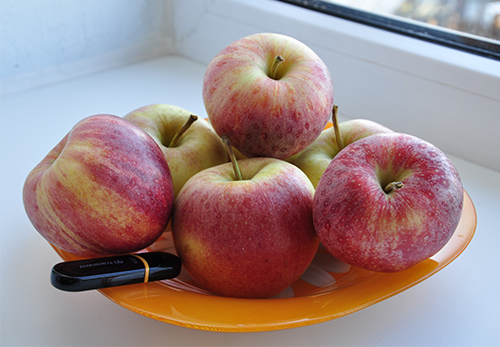
The trees are medium-sized. Crohn broadly oval, medium thickening. Skeletal branches are of medium strength; when they leave the trunk, they form an angle of 45 to 75 degrees, the ends are directed upwards. Fruiting of a mixed type, fruits are tied on ringlets, fruit twigs and tops of annual growths.
Trees bloom in mid-late periods. The pollen has a good viability (73 to 89%). Gala belongs to the partially self-pollinated varieties. The best pollinators are Elstar, Katya, James Grieve.
The fruits are rather one-dimensional, usually of medium size, one apple weighs on average 115 - 145 grams (the maximum weight does not exceed 170 g). The shape of the fruit can be round or round-cut-conical, the ribbing is poorly expressed and is noticeable mainly on the top of the apple. The main color of the fruit is yellow or greenish-yellow, the integumentary color is expressed in the form of a striped-blurred blush of an orange-red hue practically on the entire surface of the fruit. The skin is dry, thin, but firm.
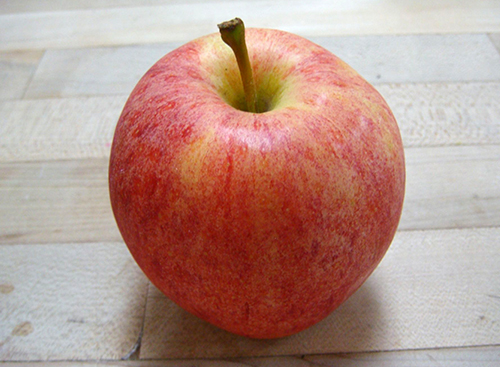
The pulp has a light yellow color and a dense, granular structure, the taste is juicy, sour-sweet (but moderate sweetness), crunchy, brittle, with a pleasant, fresh nutty-caramel flavor. On a 5-point tasting scale, the evaluation of the taste of apples is 4.6 points. It should be noted that when evaluating the fruits of this variety, three main indicators are always used - freshness, hardness and sweetness. Apples can be used for various purposes: fresh consumption, drying, processing into juices, compotes, jams, mashed potatoes, preserves
The period of removable ripeness of fruits falls in the second half of September, the consumption period begins only in November. In storage conditions, apples are perfectly stored up to 2 - 2.5 months, in a refrigerator, the shelf life increases to 6 months. The long storage period of the fruits is also favored by their high resistance to falls. The indicator of transportability is at an average level.
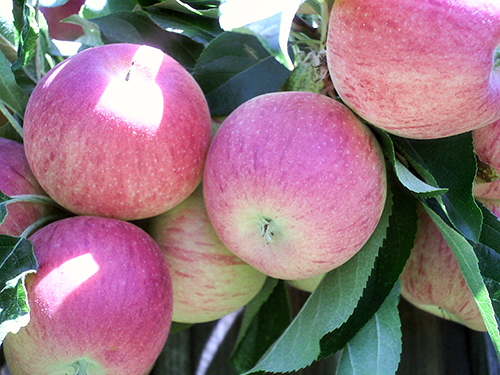
Fruiting begins at 6 - 7 years after planting on a vigorous rootstock and at 3 - 4 years on a dwarf rootstock. Young apple trees bear fruit annually and form a moderate harvest. In general, the yield is quite high, from 55 to 80 kg of fruits can be harvested from an adult tree. It is also worth noting that the variety has a tendency to overload the crop, in which case the apples become smaller.
Average winter hardiness, apple trees can withstand short-term frosts down to minus 28 ° C. Resistance to scab is medium, to powdery mildew - quite high. The variety also has a very high susceptibility to European crayfish. Possible damage by bacterial burns, moth and moniliosis.
Since the fruits can become shallow when the crop is overloaded, when caring for trees, it is necessary to normalize the total number of flowers and thin out the ovaries to improve the commercial quality of apples.
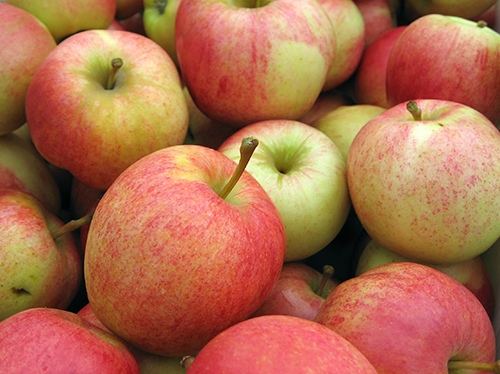
The main advantages of the Gala apple are: excellent dessert taste of the fruits and the possibility of using them for various purposes, high and regular yield, early fruiting, high keeping rates and apple resistance to falls.
The main disadvantages include: a tendency to crumbling of already not too large fruits when the trees are overloaded with crops, insufficient winter hardiness, high susceptibility to certain diseases.
It is also worth noting that the Gala variety has a large number of clones. Currently, more than 20 hybrid forms with a more intense color of fruits have been created. After breeding Gala, it was considered that the fruits of a new variety of medium and below average size with an insufficiently bright cover color would not attract the attention of buyers who were accustomed to more colorful and large apples. Of course, the situation began to change sharply for the better after the brightly colored Gala mutants appeared on the fruit market. Among them: Scarlet Gala, Royal Gala, Extremely Red Gala, Royal Gala, Ultrared Gala, Big red Gala, Galaxy, Mitchgla, Spur red Gala, El Niño and others.
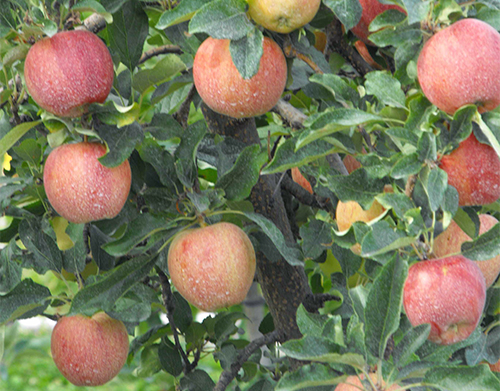
The very first clone was the Royal Gala variety (other names are Tenroy and Ten Hove Gala). It was discovered by the gardener Ten Hove in Matamata (New Zealand). The active introduction of this apple tree into orchards began in 1973; now it is planted with huge areas in industrial plantings in Europe and America. Moreover, according to the main characteristics (the nature of growth, requirements for climate, soil and agricultural technology, morphological characteristics of vegetative organs) Royal Gala is no different from the original variety. The difference is visible only in the shape of the fruit (it is cut-cone-shaped) and its integumentary color (a blurred saturated blush of a dark red hue on the entire surface of the apple, sometimes there are also darker strokes). The flesh color is also more intense.
The mutant Mondial Gala (in other words - Mitchgla or Imperial Gala) is very popular. It was discovered in 1978 by the gardener D. Mitchell in Hastings (New Zealand). The shape of the fruits, in comparison with the original, is more elongated, the integumentary color is presented in the form of a brownish-red blush over the entire surface of the apple and it begins to form only 3 weeks before the removable ripeness of the fruit. Also, on Mondial Gala apple trees, apples with a barely noticeable blurry-striped orange-red blush can form on ½ of the fruit surface.
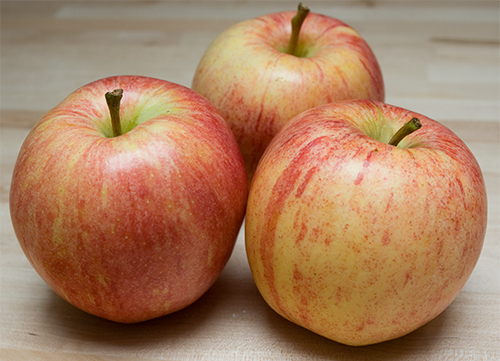
Another popular mutant is Gala Mast (other names are Regal Queen, Regal Gala, Regal Prince Gala). It was discovered near Hastings (New Zealand), in the garden of N. Fulvord. Unlike the original variety, its resistance to powdery mildew is below average. The best pollinators of Gala Mast are varieties Idared, Elstar (and clones), Gloucester (and clones) and Melrose. Fruits are set most often on 2-year-old, 3-year-old ringlets and annual growths. The flowering is intense, the fruiting is very generous. Frequency of fruiting is possible without thinning the ovaries. As for the fruits, they are larger and slightly wider in the area of the calyx. The average weight of an apple is 160 - 173 g. This is the largest-fruited mutant of Gala. The shape of the fruit is round-conical. The cover color is very attractive and rich, manifests itself by the end of August, expressed in the form of a bright blurry red carmine blush. The pulp has a yellowish cream color. During storage, the fruit can be affected by gray mold and bitter rot.
Among all the hybrid varieties of Gala, the most famous are Jazz and Delfoga. New, less studied clones of Gala include apple trees: Galaxy, Spur red Gala, Scarlet Gala, Gala Rouge and Galagored (otherwise - Cooper Gala).
